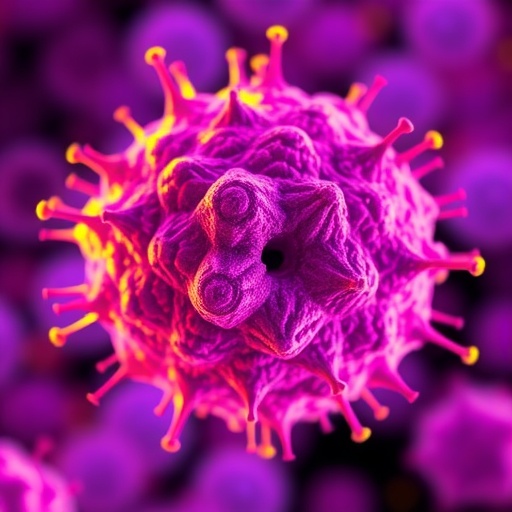
Hepatocellular carcinoma (HCC) is one of the most formidable challenges in oncology today. Representing the predominant form of liver cancer and ranking as the third-leading cause of cancer-related mortality worldwide, HCC’s aggressive nature and resistance to conventional therapies have long stymied clinicians and researchers alike. Yet, recent groundbreaking work at the VCU Massey Comprehensive Cancer Center, led by Dr. Devanand Sarkar, M.B.B.S., Ph.D., is illuminating a promising new molecular target that could revolutionize treatment strategies for this devastating disease. The study identifies the gene TATA-box binding protein associated factor 2 (TAF2) as a critical driver in hepatocyte survival and hepatocellular tumorigenesis, heralding new avenues for targeted therapy development.
Dr. Sarkar’s research team applied rigorous preclinical models to underscore TAF2’s pivotal role in liver cancer progression. Through comparative analyses of liver tissues, they demonstrated a marked overexpression of TAF2 in hepatocellular carcinoma specimens relative to normal liver biopsies. This aberrant upregulation suggests that TAF2 is not merely a bystander but actively contributes to tumor biology. Subsequent mechanistic studies revealed that TAF2 exerts regulatory control over hepatocyte viability, orchestrating pathways that promote cell survival and facilitating the transition from normal tissue to neoplasia. Such molecular insight is critical, as hepatocytes form the functional backbone of the liver, and their dysregulation is central to HCC pathogenesis.
Further complicating the tumorigenic landscape is the interaction between TAF2 and well-established oncogenes. Specifically, the research highlights a synergistic relationship between TAF2 and the MYC gene, a notorious player in multiple cancers known for driving unchecked cellular proliferation. This cooperation accelerates tumor growth dynamics, making tumors more aggressive and less responsive to existing treatments. By illuminating the molecular crosstalk that amplifies malignancy, this research offers a nuanced understanding of how combinatorial gene functions potentiate liver cancer progression.
.adsslot_t0rohK7V3A{width:728px !important;height:90px !important;}
@media(max-width:1199px){ .adsslot_t0rohK7V3A{width:468px !important;height:60px !important;}
}
@media(max-width:767px){ .adsslot_t0rohK7V3A{width:320px !important;height:50px !important;}
}
ADVERTISEMENT
Given these foundational findings, Dr. Sarkar is now poised to transition from discovery to translational medicine. The team envisions the development of novel therapeutics aimed explicitly at inhibiting TAF2 function, either as monotherapy or in combination with MYC-targeted treatments. The rationale stems from the hypothesis that dual targeting could disrupt the tumor-supportive microenvironment more effectively than single-agent interventions, potentially overcoming the limitations of current therapies that suffer from low remission rates.
The urgency of this research is magnified by the complex pathophysiology of HCC. The liver’s unique metabolic role renders it especially vulnerable to damage, and many HCC cases arise in livers already compromised by chronic injury—commonly from viral hepatitis infections, alcohol abuse, or metabolic syndromes such as non-alcoholic fatty liver disease. The resultant fibrosis and cirrhosis create a hostile environment that normalizes cellular proliferation checkpoints, fostering malignant transformation. Additionally, the liver’s impaired detoxification capability often precludes the safe administration of cytotoxic drugs, thereby narrowing therapeutic options.
Diagnostically, HCC is notoriously insidious. Early-stage disease frequently produces nonspecific symptoms that are easily overlooked, leading to delayed diagnosis. By the time definitive detection occurs, patients typically present with advanced tumors unsuitable for curative interventions like liver transplantation. Consequently, effective systemic therapies are desperately needed to extend survival and improve quality of life for these patients.
Current standard-of-care approaches for advanced HCC involve combination immunotherapies that, while innovative, achieve a remission rate of roughly 27%, leaving significant room for progress. This stark statistic reflects the urgent necessity to delve deeper into the molecular underpinnings of HCC to identify new targets and design precision therapeutics. Dr. Sarkar’s dedication to understanding TAF2’s role is a critical step in this direction, focusing on the molecular architecture that drives disease progression.
This research has benefitted from substantial funding, including a $13 million P01 grant awarded by the National Cancer Institute. This grant supports a multidisciplinary team of scientists at Massey, each leading complementary projects aimed at deciphering tumor biology and pinpointing actionable targets. Collaborators such as Drs. Arun Sanyal, Huiping Zhou, Shawn Wang, and Paul B. Fisher augment the project’s scope, ensuring a comprehensive attack on the multifactorial challenges posed by liver cancer.
Dr. Sarkar’s team is optimistic that by delineating the functional contributions of TAF2 in hepatocytes and tumors, they can pioneer therapeutic regimens that suppress tumor growth and inhibit metastatic spread. Their approach anticipates that targeted inhibition of TAF2 will not only stall tumor development but also sensitize malignant cells to additional treatments, including immunotherapies or chemotherapy, thereby enhancing overall efficacy.
The broader implications of this discovery extend beyond hepatocellular carcinoma. Preliminary data suggests that TAF2 overexpression is also evident in other cancer types, raising the possibility that TAF2 may serve as a universal oncogenic facilitator across multiple tissues. This expands the horizon for therapeutic targeting of TAF2, making it a gene of exceptional interest in the oncology field at large.
Published in the prestigious journal Hepatology in May 2025, this pioneering study combines molecular genetics, cell biology, and clinical oncology to chart a novel course for HCC research. The article outlines the critical experimental evidence supporting TAF2’s role and delineates pathways for future investigation and drug development, setting a new standard for liver cancer research.
As the scientific community eagerly watches, Dr. Sarkar and his colleagues continue to unravel the complexities of TAF2’s function. Their work promises to usher in a new era of targeted treatments capable of improving survival outcomes and bringing hope to patients grappling with liver cancer’s formidable prognosis. The meticulous dissection of TAF2’s biology marks a substantial leap forward in the relentless battle against one of the world’s deadliest cancers.
Subject of Research: Hepatocellular carcinoma, gene TAF2, hepatocyte survival, tumorigenesis, targeted cancer therapies
Article Title: TATA-box binding protein associated factor 2 (TAF2) in hepatocyte survival and tumorigenesis
News Publication Date: 19-May-2025
Web References:
Hepatology Journal Abstract: https://journals.lww.com/hep/abstract/9900/tata_box_binding_protein_associated_factor_2.1287.aspx
DOI Link: http://dx.doi.org/10.1097/HEP.0000000000001406
References: National Cancer Institute P01 grant supporting the project
Keywords: Liver cancer, Hepatocellular carcinoma, Gene targeting, Combination therapies, Cancer treatments
Tags: aberrant gene expression in cancercancer-related mortality causeshepatocellular carcinoma researchhepatocyte survival pathwaysliver cancer progression mechanismsliver cancer treatment strategiesmolecular targets in oncologypreclinical models in cancer researchtargeted therapy for liver cancerTATA-box binding protein associated factor 2tumor biology in hepatocellular carcinomaVCU Massey Comprehensive Cancer Center research





